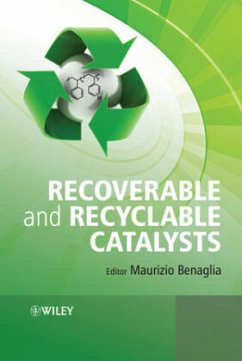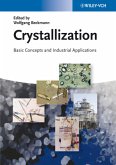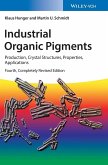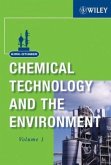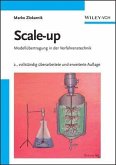Recoverable and Recyclable Catalysts
Ed. by Maurizio Benaglia
Recoverable and Recyclable Catalysts
Ed. by Maurizio Benaglia
- Gebundenes Buch
- Merkliste
- Auf die Merkliste
- Bewerten Bewerten
- Teilen
- Produkt teilen
- Produkterinnerung
- Produkterinnerung
Drawing on international research, Recoverable and Recyclable Catalysts provides the essentials on recoverable and recyclable catalysts. This practical guide explores the general principles of catalyst recovery and recycling, catalysts on insoluble or soluble supports, thermoresponsive catalysts, self-supported catalysts, and more. Each chapter combines basic general principles, practical information on the design and synthesis of catalysts, and strategies for catalyst recovery. The book presents a comparison of several different catalytic systems. This textbook is essential for students who…mehr
Andere Kunden interessierten sich auch für
![Crystallization Crystallization]() Crystallization143,99 €
Crystallization143,99 €![Block Copolymers Block Copolymers]() Nikos HadjichristidisBlock Copolymers296,99 €
Nikos HadjichristidisBlock Copolymers296,99 €![Materials-Chirality Materials-Chirality]() Mark M. Green / R. J. M. Nolte / E. W. Meijer (Hgg.)Materials-Chirality374,99 €
Mark M. Green / R. J. M. Nolte / E. W. Meijer (Hgg.)Materials-Chirality374,99 €![Industrial Organic Pigments Industrial Organic Pigments]() Klaus HungerIndustrial Organic Pigments220,99 €
Klaus HungerIndustrial Organic Pigments220,99 €![Kirk-Othmer Chemical Technology and the Environment, 2 Volume Set Kirk-Othmer Chemical Technology and the Environment, 2 Volume Set]() WileyKirk-Othmer Chemical Technology and the Environment, 2 Volume Set788,99 €
WileyKirk-Othmer Chemical Technology and the Environment, 2 Volume Set788,99 €![Scale-up Scale-up]() Marko ZlokarnikScale-up165,00 €
Marko ZlokarnikScale-up165,00 €![Green Chemistry Metrics Green Chemistry Metrics]() Green Chemistry Metrics194,99 €
Green Chemistry Metrics194,99 €-
-
-
Drawing on international research, Recoverable and Recyclable Catalysts provides the essentials on recoverable and recyclable catalysts. This practical guide explores the general principles of catalyst recovery and recycling, catalysts on insoluble or soluble supports, thermoresponsive catalysts, self-supported catalysts, and more. Each chapter combines basic general principles, practical information on the design and synthesis of catalysts, and strategies for catalyst recovery. The book presents a comparison of several different catalytic systems. This textbook is essential for students who want to improve the efficiency and environmental acceptability of industrial processes
Hinweis: Dieser Artikel kann nur an eine deutsche Lieferadresse ausgeliefert werden.
Hinweis: Dieser Artikel kann nur an eine deutsche Lieferadresse ausgeliefert werden.
Produktdetails
- Produktdetails
- Verlag: Wiley & Sons
- 1. Auflage
- Seitenzahl: 496
- Erscheinungstermin: 1. November 2009
- Englisch
- Abmessung: 253mm x 177mm x 34mm
- Gewicht: 990g
- ISBN-13: 9780470681954
- ISBN-10: 0470681950
- Artikelnr.: 28162909
- Herstellerkennzeichnung
- Libri GmbH
- Europaallee 1
- 36244 Bad Hersfeld
- 06621 890
- Verlag: Wiley & Sons
- 1. Auflage
- Seitenzahl: 496
- Erscheinungstermin: 1. November 2009
- Englisch
- Abmessung: 253mm x 177mm x 34mm
- Gewicht: 990g
- ISBN-13: 9780470681954
- ISBN-10: 0470681950
- Artikelnr.: 28162909
- Herstellerkennzeichnung
- Libri GmbH
- Europaallee 1
- 36244 Bad Hersfeld
- 06621 890
Maurizio Benaglia is Associate Professor at the Department of Organic and Industrial Chemistry, University of Milan, Italy. He is author of over ninety publications in international scientific journals, including five review articles. His current research focuses on stereoselective reactions, synthesis of chiral supramolecular systems, synthesis of supported organometallic and metal-free catalysts, and design and synthesis of new chiral catalysts, and environmentally pure catalysts.
Preface.
Acknowledgements.
Contributors.
1 The Experimental Assay of Catalyst Recovery: General Concepts (John A.
Gladysz).
1.1 Introduction.
1.2 Catalyst Precursor vs Catalyst.
1.3 Catalyst vs Catalyst Resting State.
1.4 Catalyst Inventory: Loss Mechanisms.
1.5 Evaluation of Catalyst Recovery.
1.6 Prospective.
References.
2 Surface-functionalized Nanoporous Catalysts for Renewable Chemistry (
Brian G. Trewyn, Hung-Ting Chen and Victor S.-Y. Lin).
2.1 Introduction.
2.2 Immobilization Strategies of Heterogeneous Catalysts.
2.3 Efficient Heterogeneous Catalysts with Enhanced Reactivity and
Selectivity with Functionality.
2.4 Other Heterogeneous Catalyst Systems on Nonsilica Supports.
2.5 Conclusion.
References.
3 Insoluble Resin-supported Catalysts (Gang Zhao and Zhuo Chai).
3.1 Introduction.
3.2 Transition Metal Catalyzed C_C Bond Formation Reactions.
3.3 Oxidation.
3.4 Reduction.
3.5 Organocatalyzed Reactions.
3.6 Annulation Reactions.
3.7 Miscellaneous.
3.8 Conclusion.
References.
4 Catalysts Bound to Soluble Polymers (Tamilselvi Chinnusamy, Petra Hilgers
and Oliver Reiser).
4.1 Introduction.
4.2 Soluble Supports - General Considerations.
4.3 Recent Developments of Soluble Polymer-supported Catalysts.
4.4 Recent Examples for Reactions Promoted by Catalysts Bound to Soluble
Polymers.
4.5 Conclusion.
List of Abbreviations.
References.
5 Polymeric, Recoverable Catalytic Systems (Qiao-Sheng Hu).
5.1 Introduction.
5.2 Polymeric Catalyst Systems.
5.3 Summary.
Acknowledgements.
References.
6 Thermomorphic Catalysts (David E. Bergbreiter).
6.1 Introduction.
6.2 Thermomorphic Catalyst Separation Strategies.
6.3 Hydrogenation Reactions Under Thermomorphic Conditions.
6.4 Hydroformylation Reactions Under Thermomorphic Conditions.
6.5 Hydroaminations Under Thermomorphic Conditions.
6.6 Pd-catalyzed Reactions Under Thermomorphic Conditions.
6.7 Polymerization Reactions Under Thermomorphic Conditions.
6.8 Organocatalysis Under Thermomorphic Conditions.
6.9 Cu(I)-catalyzed 1,3-Dipolar Cycloadditions Under Thermomorphic
Conditions.
6.10 Thermomorphic Hydrosilylation Catalysts.
6.11 Thermomorphic Catalytic Oxidations.
6.12 Conclusions.
References.
7 Self-supported Asymmetric Catalysts (Wenbin Lin and David J. Mihalcik).
7.1 Introduction.
7.2 Self-supported Asymmetric Catalysts Formed by Linking Catalytically
Active Subunits via Metal-Ligand Coordination.
7.3 Self-supported Asymmetric Catalysts Formed by Post-synthetic
Modifications of Coordination Polymers.
7.4 Self-supported Asymmetric Catalysts Formed by Linking Multitopic Chiral
Ligands with Catalytic Metal Centers.
7.5 Conclusions and Outlook.
Acknowledgments.
References.
8 Fluorous Chiral Catalyst Immobilization (Tibor Soós).
8.1 Introduction.
8.2 Fluorous Chemistry and its Basic Recovery Concepts.
8.3 Application of Fluorous Chiral Catalysts.
8.4 Summary.
References.
9 Biphasic Catalysis: Catalysis in Supercritical CO2 and in Water (Simon L.
Desset and David J. Cole-Hamilton).
9.1 Introduction.
9.2 Biphasic Catalysis.
9.3 Aqueous Biphasic Catalysis.
9.4 Supercritical Carbon Dioxide.
9.5 Conclusion.
References.
10 Asymmetric Catalysis in Ionic Liquids (Lijin Xu and Jianliang Xiao).
10.1 Introduction.
10.2 Metal-catalyzed Asymmetric Reactions in ILs.
10.3 Asymmetric Organocatalytic Reactions in ILs.
10.4 Concluding Remarks.
References.
11 Recoverable Organic Catalysts (Maurizio Benaglia).
11.1 Introduction.
11.2 Achiral Organic Catalysts.
11.3 Chiral Organic Catalysts.
11.4 Catalysts Derived from Amino Acids.
11.5 General Considerations on Recyclable Organocatalysts.
11.6 Outlook and Perspectives.
References.
12 Organic Polymer-microencapsulated Metal Catalysts (Jun Ou and Patrick H.
Toy).
12.1 Introduction.
12.2 Non-cross-linked Polymer-microencapsulated Catalysts.
12.3 Cross-linked Polymer-microencapsulated Catalysts.
12.4 Summary Table.
12.5 Conclusions.
References.
13 Organic Synthesis with Mini Flow Reactors Using Immobilised Catalysts (
Sascha Ceylan and Andreas Kirschning).
13.1 Introduction.
13.2 Catalysis in Mini Flow Reactors with Immobilised Catalysts.
13.3 Miscellaneous Enabling Techniques for Mini Flow Systems.
13.4 Perspectives and Outlook.
References.
14 Homogeneous Catalysis Using Microreactor Technology (Johan C. Brandt and
Thomas Wirth).
14.1 Introduction.
14.2 Acid-catalysed Reactions.
14.3 Liquid-liquid Biphasic Systems.
14.4 Photocatalysis.
14.5 Asymmetric Catalytic Reactions.
14.6 Unusual Reaction Conditions.
References.
15 Catalyst Immobilization Strategy: Some General Considerations and a
Comparison of the Main Features of Different Supports (Franco Cozzi).
15.1 Introduction.
15.2 General Considerations on Catalyst Immobilization.
15.3 Comparison of Different Supports Employed for the Immobilization of
Proline.
15.4 Comparison of Different Supports Employed for the Immobilization of
Bis(oxazolines).
15.5 Conclusions.
References.
Index.
Acknowledgements.
Contributors.
1 The Experimental Assay of Catalyst Recovery: General Concepts (John A.
Gladysz).
1.1 Introduction.
1.2 Catalyst Precursor vs Catalyst.
1.3 Catalyst vs Catalyst Resting State.
1.4 Catalyst Inventory: Loss Mechanisms.
1.5 Evaluation of Catalyst Recovery.
1.6 Prospective.
References.
2 Surface-functionalized Nanoporous Catalysts for Renewable Chemistry (
Brian G. Trewyn, Hung-Ting Chen and Victor S.-Y. Lin).
2.1 Introduction.
2.2 Immobilization Strategies of Heterogeneous Catalysts.
2.3 Efficient Heterogeneous Catalysts with Enhanced Reactivity and
Selectivity with Functionality.
2.4 Other Heterogeneous Catalyst Systems on Nonsilica Supports.
2.5 Conclusion.
References.
3 Insoluble Resin-supported Catalysts (Gang Zhao and Zhuo Chai).
3.1 Introduction.
3.2 Transition Metal Catalyzed C_C Bond Formation Reactions.
3.3 Oxidation.
3.4 Reduction.
3.5 Organocatalyzed Reactions.
3.6 Annulation Reactions.
3.7 Miscellaneous.
3.8 Conclusion.
References.
4 Catalysts Bound to Soluble Polymers (Tamilselvi Chinnusamy, Petra Hilgers
and Oliver Reiser).
4.1 Introduction.
4.2 Soluble Supports - General Considerations.
4.3 Recent Developments of Soluble Polymer-supported Catalysts.
4.4 Recent Examples for Reactions Promoted by Catalysts Bound to Soluble
Polymers.
4.5 Conclusion.
List of Abbreviations.
References.
5 Polymeric, Recoverable Catalytic Systems (Qiao-Sheng Hu).
5.1 Introduction.
5.2 Polymeric Catalyst Systems.
5.3 Summary.
Acknowledgements.
References.
6 Thermomorphic Catalysts (David E. Bergbreiter).
6.1 Introduction.
6.2 Thermomorphic Catalyst Separation Strategies.
6.3 Hydrogenation Reactions Under Thermomorphic Conditions.
6.4 Hydroformylation Reactions Under Thermomorphic Conditions.
6.5 Hydroaminations Under Thermomorphic Conditions.
6.6 Pd-catalyzed Reactions Under Thermomorphic Conditions.
6.7 Polymerization Reactions Under Thermomorphic Conditions.
6.8 Organocatalysis Under Thermomorphic Conditions.
6.9 Cu(I)-catalyzed 1,3-Dipolar Cycloadditions Under Thermomorphic
Conditions.
6.10 Thermomorphic Hydrosilylation Catalysts.
6.11 Thermomorphic Catalytic Oxidations.
6.12 Conclusions.
References.
7 Self-supported Asymmetric Catalysts (Wenbin Lin and David J. Mihalcik).
7.1 Introduction.
7.2 Self-supported Asymmetric Catalysts Formed by Linking Catalytically
Active Subunits via Metal-Ligand Coordination.
7.3 Self-supported Asymmetric Catalysts Formed by Post-synthetic
Modifications of Coordination Polymers.
7.4 Self-supported Asymmetric Catalysts Formed by Linking Multitopic Chiral
Ligands with Catalytic Metal Centers.
7.5 Conclusions and Outlook.
Acknowledgments.
References.
8 Fluorous Chiral Catalyst Immobilization (Tibor Soós).
8.1 Introduction.
8.2 Fluorous Chemistry and its Basic Recovery Concepts.
8.3 Application of Fluorous Chiral Catalysts.
8.4 Summary.
References.
9 Biphasic Catalysis: Catalysis in Supercritical CO2 and in Water (Simon L.
Desset and David J. Cole-Hamilton).
9.1 Introduction.
9.2 Biphasic Catalysis.
9.3 Aqueous Biphasic Catalysis.
9.4 Supercritical Carbon Dioxide.
9.5 Conclusion.
References.
10 Asymmetric Catalysis in Ionic Liquids (Lijin Xu and Jianliang Xiao).
10.1 Introduction.
10.2 Metal-catalyzed Asymmetric Reactions in ILs.
10.3 Asymmetric Organocatalytic Reactions in ILs.
10.4 Concluding Remarks.
References.
11 Recoverable Organic Catalysts (Maurizio Benaglia).
11.1 Introduction.
11.2 Achiral Organic Catalysts.
11.3 Chiral Organic Catalysts.
11.4 Catalysts Derived from Amino Acids.
11.5 General Considerations on Recyclable Organocatalysts.
11.6 Outlook and Perspectives.
References.
12 Organic Polymer-microencapsulated Metal Catalysts (Jun Ou and Patrick H.
Toy).
12.1 Introduction.
12.2 Non-cross-linked Polymer-microencapsulated Catalysts.
12.3 Cross-linked Polymer-microencapsulated Catalysts.
12.4 Summary Table.
12.5 Conclusions.
References.
13 Organic Synthesis with Mini Flow Reactors Using Immobilised Catalysts (
Sascha Ceylan and Andreas Kirschning).
13.1 Introduction.
13.2 Catalysis in Mini Flow Reactors with Immobilised Catalysts.
13.3 Miscellaneous Enabling Techniques for Mini Flow Systems.
13.4 Perspectives and Outlook.
References.
14 Homogeneous Catalysis Using Microreactor Technology (Johan C. Brandt and
Thomas Wirth).
14.1 Introduction.
14.2 Acid-catalysed Reactions.
14.3 Liquid-liquid Biphasic Systems.
14.4 Photocatalysis.
14.5 Asymmetric Catalytic Reactions.
14.6 Unusual Reaction Conditions.
References.
15 Catalyst Immobilization Strategy: Some General Considerations and a
Comparison of the Main Features of Different Supports (Franco Cozzi).
15.1 Introduction.
15.2 General Considerations on Catalyst Immobilization.
15.3 Comparison of Different Supports Employed for the Immobilization of
Proline.
15.4 Comparison of Different Supports Employed for the Immobilization of
Bis(oxazolines).
15.5 Conclusions.
References.
Index.
Preface.
Acknowledgements.
Contributors.
1 The Experimental Assay of Catalyst Recovery: General Concepts (John A.
Gladysz).
1.1 Introduction.
1.2 Catalyst Precursor vs Catalyst.
1.3 Catalyst vs Catalyst Resting State.
1.4 Catalyst Inventory: Loss Mechanisms.
1.5 Evaluation of Catalyst Recovery.
1.6 Prospective.
References.
2 Surface-functionalized Nanoporous Catalysts for Renewable Chemistry (
Brian G. Trewyn, Hung-Ting Chen and Victor S.-Y. Lin).
2.1 Introduction.
2.2 Immobilization Strategies of Heterogeneous Catalysts.
2.3 Efficient Heterogeneous Catalysts with Enhanced Reactivity and
Selectivity with Functionality.
2.4 Other Heterogeneous Catalyst Systems on Nonsilica Supports.
2.5 Conclusion.
References.
3 Insoluble Resin-supported Catalysts (Gang Zhao and Zhuo Chai).
3.1 Introduction.
3.2 Transition Metal Catalyzed C_C Bond Formation Reactions.
3.3 Oxidation.
3.4 Reduction.
3.5 Organocatalyzed Reactions.
3.6 Annulation Reactions.
3.7 Miscellaneous.
3.8 Conclusion.
References.
4 Catalysts Bound to Soluble Polymers (Tamilselvi Chinnusamy, Petra Hilgers
and Oliver Reiser).
4.1 Introduction.
4.2 Soluble Supports - General Considerations.
4.3 Recent Developments of Soluble Polymer-supported Catalysts.
4.4 Recent Examples for Reactions Promoted by Catalysts Bound to Soluble
Polymers.
4.5 Conclusion.
List of Abbreviations.
References.
5 Polymeric, Recoverable Catalytic Systems (Qiao-Sheng Hu).
5.1 Introduction.
5.2 Polymeric Catalyst Systems.
5.3 Summary.
Acknowledgements.
References.
6 Thermomorphic Catalysts (David E. Bergbreiter).
6.1 Introduction.
6.2 Thermomorphic Catalyst Separation Strategies.
6.3 Hydrogenation Reactions Under Thermomorphic Conditions.
6.4 Hydroformylation Reactions Under Thermomorphic Conditions.
6.5 Hydroaminations Under Thermomorphic Conditions.
6.6 Pd-catalyzed Reactions Under Thermomorphic Conditions.
6.7 Polymerization Reactions Under Thermomorphic Conditions.
6.8 Organocatalysis Under Thermomorphic Conditions.
6.9 Cu(I)-catalyzed 1,3-Dipolar Cycloadditions Under Thermomorphic
Conditions.
6.10 Thermomorphic Hydrosilylation Catalysts.
6.11 Thermomorphic Catalytic Oxidations.
6.12 Conclusions.
References.
7 Self-supported Asymmetric Catalysts (Wenbin Lin and David J. Mihalcik).
7.1 Introduction.
7.2 Self-supported Asymmetric Catalysts Formed by Linking Catalytically
Active Subunits via Metal-Ligand Coordination.
7.3 Self-supported Asymmetric Catalysts Formed by Post-synthetic
Modifications of Coordination Polymers.
7.4 Self-supported Asymmetric Catalysts Formed by Linking Multitopic Chiral
Ligands with Catalytic Metal Centers.
7.5 Conclusions and Outlook.
Acknowledgments.
References.
8 Fluorous Chiral Catalyst Immobilization (Tibor Soós).
8.1 Introduction.
8.2 Fluorous Chemistry and its Basic Recovery Concepts.
8.3 Application of Fluorous Chiral Catalysts.
8.4 Summary.
References.
9 Biphasic Catalysis: Catalysis in Supercritical CO2 and in Water (Simon L.
Desset and David J. Cole-Hamilton).
9.1 Introduction.
9.2 Biphasic Catalysis.
9.3 Aqueous Biphasic Catalysis.
9.4 Supercritical Carbon Dioxide.
9.5 Conclusion.
References.
10 Asymmetric Catalysis in Ionic Liquids (Lijin Xu and Jianliang Xiao).
10.1 Introduction.
10.2 Metal-catalyzed Asymmetric Reactions in ILs.
10.3 Asymmetric Organocatalytic Reactions in ILs.
10.4 Concluding Remarks.
References.
11 Recoverable Organic Catalysts (Maurizio Benaglia).
11.1 Introduction.
11.2 Achiral Organic Catalysts.
11.3 Chiral Organic Catalysts.
11.4 Catalysts Derived from Amino Acids.
11.5 General Considerations on Recyclable Organocatalysts.
11.6 Outlook and Perspectives.
References.
12 Organic Polymer-microencapsulated Metal Catalysts (Jun Ou and Patrick H.
Toy).
12.1 Introduction.
12.2 Non-cross-linked Polymer-microencapsulated Catalysts.
12.3 Cross-linked Polymer-microencapsulated Catalysts.
12.4 Summary Table.
12.5 Conclusions.
References.
13 Organic Synthesis with Mini Flow Reactors Using Immobilised Catalysts (
Sascha Ceylan and Andreas Kirschning).
13.1 Introduction.
13.2 Catalysis in Mini Flow Reactors with Immobilised Catalysts.
13.3 Miscellaneous Enabling Techniques for Mini Flow Systems.
13.4 Perspectives and Outlook.
References.
14 Homogeneous Catalysis Using Microreactor Technology (Johan C. Brandt and
Thomas Wirth).
14.1 Introduction.
14.2 Acid-catalysed Reactions.
14.3 Liquid-liquid Biphasic Systems.
14.4 Photocatalysis.
14.5 Asymmetric Catalytic Reactions.
14.6 Unusual Reaction Conditions.
References.
15 Catalyst Immobilization Strategy: Some General Considerations and a
Comparison of the Main Features of Different Supports (Franco Cozzi).
15.1 Introduction.
15.2 General Considerations on Catalyst Immobilization.
15.3 Comparison of Different Supports Employed for the Immobilization of
Proline.
15.4 Comparison of Different Supports Employed for the Immobilization of
Bis(oxazolines).
15.5 Conclusions.
References.
Index.
Acknowledgements.
Contributors.
1 The Experimental Assay of Catalyst Recovery: General Concepts (John A.
Gladysz).
1.1 Introduction.
1.2 Catalyst Precursor vs Catalyst.
1.3 Catalyst vs Catalyst Resting State.
1.4 Catalyst Inventory: Loss Mechanisms.
1.5 Evaluation of Catalyst Recovery.
1.6 Prospective.
References.
2 Surface-functionalized Nanoporous Catalysts for Renewable Chemistry (
Brian G. Trewyn, Hung-Ting Chen and Victor S.-Y. Lin).
2.1 Introduction.
2.2 Immobilization Strategies of Heterogeneous Catalysts.
2.3 Efficient Heterogeneous Catalysts with Enhanced Reactivity and
Selectivity with Functionality.
2.4 Other Heterogeneous Catalyst Systems on Nonsilica Supports.
2.5 Conclusion.
References.
3 Insoluble Resin-supported Catalysts (Gang Zhao and Zhuo Chai).
3.1 Introduction.
3.2 Transition Metal Catalyzed C_C Bond Formation Reactions.
3.3 Oxidation.
3.4 Reduction.
3.5 Organocatalyzed Reactions.
3.6 Annulation Reactions.
3.7 Miscellaneous.
3.8 Conclusion.
References.
4 Catalysts Bound to Soluble Polymers (Tamilselvi Chinnusamy, Petra Hilgers
and Oliver Reiser).
4.1 Introduction.
4.2 Soluble Supports - General Considerations.
4.3 Recent Developments of Soluble Polymer-supported Catalysts.
4.4 Recent Examples for Reactions Promoted by Catalysts Bound to Soluble
Polymers.
4.5 Conclusion.
List of Abbreviations.
References.
5 Polymeric, Recoverable Catalytic Systems (Qiao-Sheng Hu).
5.1 Introduction.
5.2 Polymeric Catalyst Systems.
5.3 Summary.
Acknowledgements.
References.
6 Thermomorphic Catalysts (David E. Bergbreiter).
6.1 Introduction.
6.2 Thermomorphic Catalyst Separation Strategies.
6.3 Hydrogenation Reactions Under Thermomorphic Conditions.
6.4 Hydroformylation Reactions Under Thermomorphic Conditions.
6.5 Hydroaminations Under Thermomorphic Conditions.
6.6 Pd-catalyzed Reactions Under Thermomorphic Conditions.
6.7 Polymerization Reactions Under Thermomorphic Conditions.
6.8 Organocatalysis Under Thermomorphic Conditions.
6.9 Cu(I)-catalyzed 1,3-Dipolar Cycloadditions Under Thermomorphic
Conditions.
6.10 Thermomorphic Hydrosilylation Catalysts.
6.11 Thermomorphic Catalytic Oxidations.
6.12 Conclusions.
References.
7 Self-supported Asymmetric Catalysts (Wenbin Lin and David J. Mihalcik).
7.1 Introduction.
7.2 Self-supported Asymmetric Catalysts Formed by Linking Catalytically
Active Subunits via Metal-Ligand Coordination.
7.3 Self-supported Asymmetric Catalysts Formed by Post-synthetic
Modifications of Coordination Polymers.
7.4 Self-supported Asymmetric Catalysts Formed by Linking Multitopic Chiral
Ligands with Catalytic Metal Centers.
7.5 Conclusions and Outlook.
Acknowledgments.
References.
8 Fluorous Chiral Catalyst Immobilization (Tibor Soós).
8.1 Introduction.
8.2 Fluorous Chemistry and its Basic Recovery Concepts.
8.3 Application of Fluorous Chiral Catalysts.
8.4 Summary.
References.
9 Biphasic Catalysis: Catalysis in Supercritical CO2 and in Water (Simon L.
Desset and David J. Cole-Hamilton).
9.1 Introduction.
9.2 Biphasic Catalysis.
9.3 Aqueous Biphasic Catalysis.
9.4 Supercritical Carbon Dioxide.
9.5 Conclusion.
References.
10 Asymmetric Catalysis in Ionic Liquids (Lijin Xu and Jianliang Xiao).
10.1 Introduction.
10.2 Metal-catalyzed Asymmetric Reactions in ILs.
10.3 Asymmetric Organocatalytic Reactions in ILs.
10.4 Concluding Remarks.
References.
11 Recoverable Organic Catalysts (Maurizio Benaglia).
11.1 Introduction.
11.2 Achiral Organic Catalysts.
11.3 Chiral Organic Catalysts.
11.4 Catalysts Derived from Amino Acids.
11.5 General Considerations on Recyclable Organocatalysts.
11.6 Outlook and Perspectives.
References.
12 Organic Polymer-microencapsulated Metal Catalysts (Jun Ou and Patrick H.
Toy).
12.1 Introduction.
12.2 Non-cross-linked Polymer-microencapsulated Catalysts.
12.3 Cross-linked Polymer-microencapsulated Catalysts.
12.4 Summary Table.
12.5 Conclusions.
References.
13 Organic Synthesis with Mini Flow Reactors Using Immobilised Catalysts (
Sascha Ceylan and Andreas Kirschning).
13.1 Introduction.
13.2 Catalysis in Mini Flow Reactors with Immobilised Catalysts.
13.3 Miscellaneous Enabling Techniques for Mini Flow Systems.
13.4 Perspectives and Outlook.
References.
14 Homogeneous Catalysis Using Microreactor Technology (Johan C. Brandt and
Thomas Wirth).
14.1 Introduction.
14.2 Acid-catalysed Reactions.
14.3 Liquid-liquid Biphasic Systems.
14.4 Photocatalysis.
14.5 Asymmetric Catalytic Reactions.
14.6 Unusual Reaction Conditions.
References.
15 Catalyst Immobilization Strategy: Some General Considerations and a
Comparison of the Main Features of Different Supports (Franco Cozzi).
15.1 Introduction.
15.2 General Considerations on Catalyst Immobilization.
15.3 Comparison of Different Supports Employed for the Immobilization of
Proline.
15.4 Comparison of Different Supports Employed for the Immobilization of
Bis(oxazolines).
15.5 Conclusions.
References.
Index.

